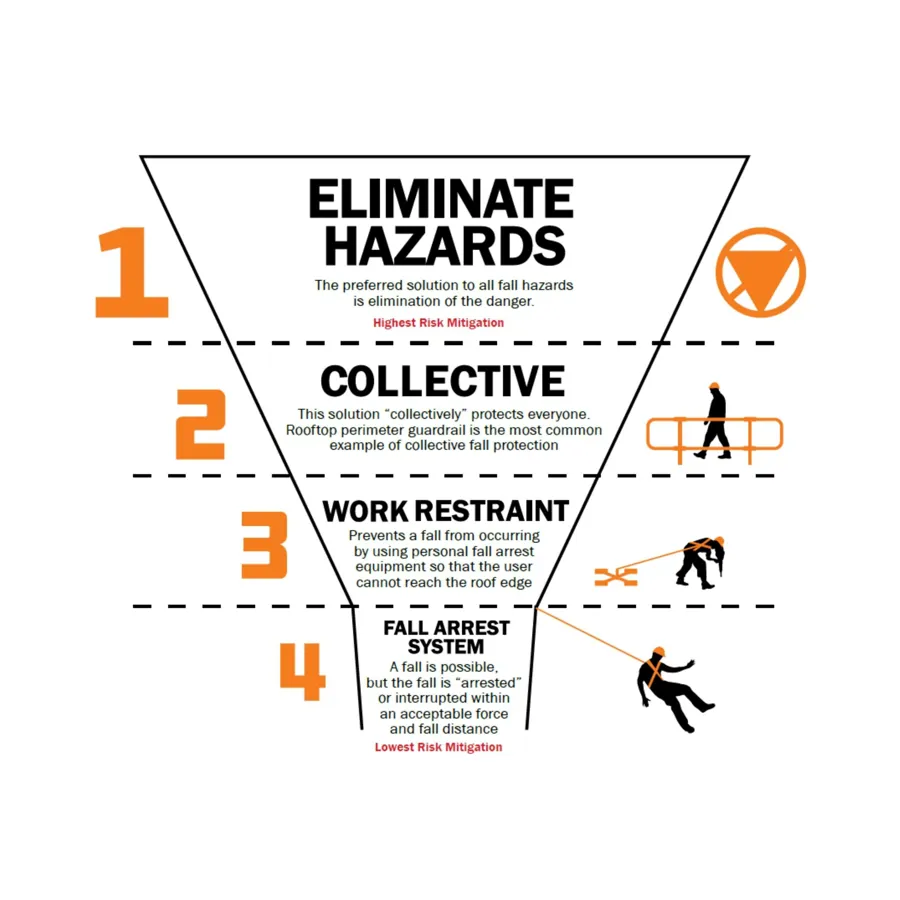
You are visiting the Canada Kee Safety website from United States. Would you like to go to the United States site?

When facility safety managers need to decide upon rooftop fall protection, they can take a tip from journalists: “Who, What, When, Where, and Why.”
Who, what, and when is anyone accessing the roof for maintenance, repairs, inspections, or other tasks. Why is clearly to protect workers and keep them safe. Where raises the question of the type of fall protection to use, travel restraint or collective?
A travel or fall restraint system is a form of Personal Protective Equipment (PPE) that limits where a person can go on the roof. Collective fall protection, such as a perimeter guardrail, is there to protect people working at heights without PPE. The limitations are within the confines of the safety railing system.
Wherever possible, a guardrail system is preferred because it is always in place to protect workers and requires no special training or upkeep. It is known as a “collective” system because several workers are protected at once when performing their tasks.
In constrained areas, on high-sloped roofs, or wherever else a collective system is not possible or practical, a travel restraint system should be used. A safe and proper system includes a Class A full body harness, a fixed-length or adjustable lanyard, a lifeline or rope, rope grab, and a sufficient anchor point.
Whether a collective or fall restraint system is employed, proper fall protection begins with understanding the distinctions between rooftop hazards. There are three zones of concern: access points, roof openings, obstacles, and unprotected edges.

Ladders are commonly used to access a roof. A self-closing safety gate connected to a roof edge railing system (with toe boards on all exposed sides) is designed to protect people from falling into a ladder way. Kee Guard®, used in conjunction with Kee Gate®, is a collective fall protection system for this purpose.
For roof hatches, Kee Hatch® has safety railings on either side of the hatch with Kee Gate® to provide both access and fall restraint. It is important to note that chains can no longer be used for fall protection at rooftop access points.
Skylights are considered openings in a roof; falling through skylights is a leading cause of injury. Either a collective or travel restraint system is acceptable to protect workers.
Kee Cover® provides a screen that covers a skylight. It is available in four formats and custom sizes. Kee Dome® is a railing system that surrounds a skylight, roof light, or dome light to help prevent falls.
Where a collective system is not present, a travel restraint system can be used as a fall arrester. Kee Line® is a horizontal lifeline system that meets this need. Kee Anchor® and Kee Post® provide anchor points for use with harnesses and lanyards.
Whenever work is performed within 1.8 meters (6 ft.) from a roof edge, there needs to be a collective guardrail system, travel restraint system, personal fall arrest system, or a safety net. (Note: personal fall arrest systems and safety nets stop—or arrest—a worker after a fall, but they are the last resort, especially nets.)
From 1.8 to 4.6 meters (6 to 15 ft.) or more, a “Designated Area” can be specified to direct workers from going near the edge; however, collective and travel restraint systems are safer and more reliable. Kee Guard® is a modular roof edge guardrail system installed without penetrating the roof membrane.
To summarize, collective fall protection is a rooftop safety railing system that is in place to protect all workers at once. Employees do not need to be trained. A regulatory-compliant system properly installed requires virtually no maintenance or further inspection.
A travel restraint system is personal protective equipment that protects the individual. Workers must be trained to don and use travel restraint systems properly. The equipment should be inspected before and after use.
Both collective and travel restraint systems can be used effectively on a flat or low-sloped roof. Although collective is preferred, travel restraint should be used where a collective system cannot be installed.

A truly comprehensive rooftop solution follows the Hierarchy of Fall Protection. An expert starts by inspecting the roof site for potential fall hazards. From there, a complete system solution and recommendations are created that descend down the four levels of the hierarchy, from simple, sensible approaches for eliminating risks all the way down to lifesaving personal protection systems.
Collective Systems require no additional training to use. Fall Restraint and Fall Arrest Systems both require a high level of user competency, training and additional inspection to be used properly.
As fall protection experts, we can perform a critical analysis on your rooftop to identify the hazards where your workers are exposed to the greatest risk. This ensures that the most dangerous areas are protected immediately with state-of-the-art systems and OH&S compliant solutions.